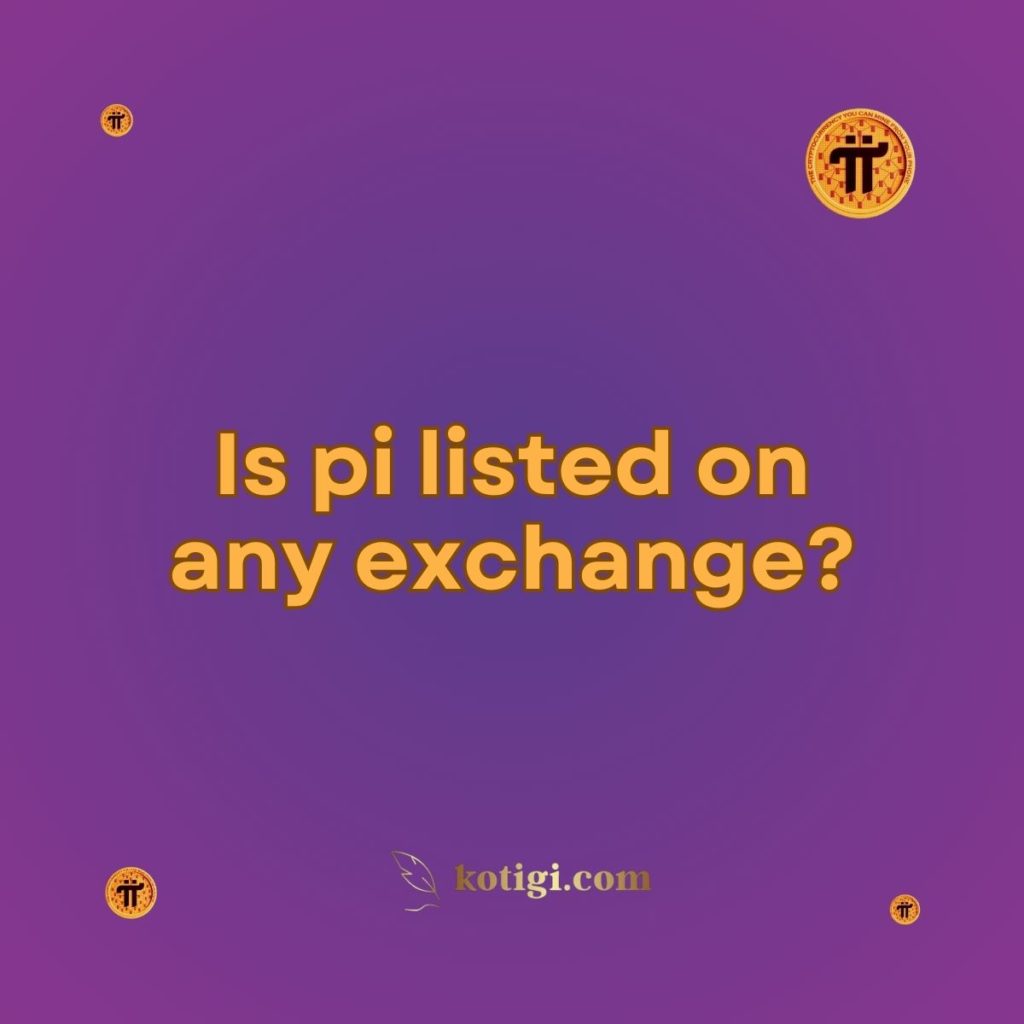
Is pi listed on any exchange?
Currently, Pi Network is not listed on any cryptocurrency exchange. The project is still in its enclosed Mainnet phase, meaning that Pi cannot be traded publicly on exchanges like Binance, Coinbase, or any other platform. Once Pi transitions to its open Mainnet and meets necessary regulatory and technical criteria, it could be listed on various exchanges. Until then, any claims of Pi being listed are false and misleading.
Introduction
Pi Network, a project with millions of global users, is one of the most anticipated cryptocurrencies for future exchange listings. With its unique mobile mining approach, Pi has attracted widespread attention. However, despite its popularity, Pi is not listed on any cryptocurrency exchange as of now. This is primarily due to its developmental stage, where the coin is in an enclosed Mainnet, preventing public trading.
In this article, we will explore the current status of Pi’s listing on exchanges, the reasons behind its absence from the market, and what we can expect moving forward.
The Enclosed Mainnet Phase
What Is the Enclosed Mainnet?
Pi Network is currently in the enclosed Mainnet phase, a crucial step in its development process. During this phase, Pi’s blockchain operates independently, but it is closed off from external networks and exchanges. This means that while users can mine and transfer Pi within the Pi ecosystem, they cannot trade it on public cryptocurrency exchanges like Binance, Coinbase, or Kraken.
The purpose of this phase is to strengthen the network, allow users to complete the KYC (Know Your Customer) process, and prepare for the transition to the open Mainnet, where Pi coins will be tradable.
Why Pi Is Not Yet Listed on Exchanges?
There are several reasons why Pi is not yet listed on any exchange:
- Enclosed Mainnet: The most significant reason is the enclosed Mainnet. Until Pi transitions to the open Mainnet, it cannot be traded or listed on public platforms.
- Regulatory Compliance: Pi Network is focused on complying with international regulations and ensuring that its KYC process is complete for all users. Only verified users will be able to transfer and trade Pi once it is listed on exchanges.
- Development of Ecosystem: Pi Network is building a robust ecosystem that will give Pi real-world utility. The team is working to ensure that the platform is secure, scalable, and functional before allowing Pi to be listed on exchanges.
What Needs to Happen for Pi to Be Listed?
Transition to the Open Mainnet
The first and most crucial step for Pi to be listed on exchanges is the launch of the open Mainnet. Once the open Mainnet is live, Pi will no longer be restricted to its internal ecosystem, and users will be able to transfer Pi to external wallets, allowing for trading on public exchanges.
Pi Network’s development team has emphasized that the open Mainnet will not be launched until all necessary preparations are completed, including technical upgrades and widespread KYC verification.
Completing KYC Verification
KYC verification is mandatory for all Pi users who want to transfer or trade their coins in the future. This process ensures that all participants in the Pi Network are real individuals, which is a crucial requirement for regulatory compliance and exchange listings. Without completing KYC, users will not be able to access their Pi coins on the open Mainnet, which would prevent them from trading on exchanges.
Meeting Exchange Listing Criteria
Cryptocurrency exchanges have specific listing criteria that Pi Network must meet before being accepted. Some of the common requirements include:
- Regulatory compliance: Exchanges, especially large ones like Binance and Coinbase, require coins to comply with local and international financial regulations.
- Liquidity and Market Demand: Exchanges prefer to list cryptocurrencies that have high market demand and sufficient liquidity. Pi Network’s large user base could make it an attractive option for exchanges once the open Mainnet is launched.
- Technical Audits: Exchanges also require technical audits to ensure that the blockchain technology supporting the coin is secure, scalable, and functional.
Common Misconceptions About Pi Listings
False Claims of Pi Listings
There have been multiple reports of fake Pi listings on small or unauthorized exchanges. Some websites or platforms claim that Pi is listed for trading, but these claims are false and misleading. Since Pi is still in its enclosed Mainnet phase, any exchange claiming to trade Pi is not legitimate. Users should be cautious of these platforms and avoid engaging in transactions involving Pi, as they may be scams or involve counterfeit Pi tokens.
Pi Futures Trading
In some cases, exchanges or third-party platforms may offer futures contracts or speculative trading based on Pi’s potential future value. However, these are not legitimate Pi trades, as Pi is not officially available for trading on any platform. Futures contracts are often highly speculative and risky, especially when based on an asset that is not yet tradable.
What to Expect When Pi Is Listed?
Potential Exchanges for Pi Listing
Once Pi transitions to the open Mainnet, it could be listed on major cryptocurrency exchanges, provided it meets all listing requirements. Some of the exchanges where Pi could potentially be listed include:
- Binance: Binance is one of the largest cryptocurrency exchanges in the world, and Pi’s large user base could make it an attractive listing candidate. Binance typically looks for projects that have significant market demand and innovation in the blockchain space.
- Coinbase: Coinbase is a U.S.-based exchange that focuses on regulatory compliance and ease of use. Pi Network’s compliance with KYC regulations could increase its chances of being listed on Coinbase once the open Mainnet is launched.
- Kraken: Kraken is another reputable exchange known for listing cryptocurrencies that have proven technology and utility. Pi’s unique mobile mining approach and large community could appeal to Kraken’s user base.
Price Volatility
Once Pi is listed on exchanges, users should be prepared for price volatility. Newly listed cryptocurrencies often experience significant fluctuations in price due to speculative trading and high demand. Users should exercise caution and avoid making impulsive trading decisions based on short-term market movements.
Utility and Adoption
For Pi to be successful as a listed cryptocurrency, it will need to establish real-world utility and adoption. The Pi Network development team is working on building an ecosystem where Pi can be used for everyday transactions, such as payments for goods and services. If Pi achieves widespread utility, it could become more attractive to businesses and investors, leading to increased demand and stability in its price.
Preparing for Pi’s Listing
Complete KYC Verification
If you are a Pi user and want to trade or sell your Pi in the future, it’s essential to complete your KYC verification. Without KYC, you won’t be able to access your Pi coins on the open Mainnet or transfer them to exchanges for trading.
Stay Informed
Pi Network’s development team regularly provides updates on the project’s progress, including information about the open Mainnet launch and future exchange listings. Keep an eye on official Pi Network channels, such as the Pi app and social media platforms, to stay informed about any important announcements.
Learn About Cryptocurrency Trading
For users who are new to cryptocurrency trading, now is a good time to learn the basics of how exchanges work, how to set up wallets, and how to secure your assets. Once Pi is listed, being familiar with the trading process will help you make informed decisions.
Conclusion
As of now, Pi is not listed on any cryptocurrency exchange, and users cannot trade Pi publicly. Pi Network is still in its enclosed Mainnet phase, and until the project transitions to the open Mainnet, Pi will remain untradeable. Users should be cautious of any false claims or fraudulent platforms that suggest otherwise.
Once Pi completes its open Mainnet launch, it could be listed on major exchanges like Binance, Coinbase, or Kraken, provided it meets the necessary regulatory and technical requirements. In the meantime, pioneers should complete KYC verification and stay informed about the project’s progress to prepare for the eventual listing of Pi.
Key Takeaways:
- Once listed, Pi could experience price volatility, so users should approach trading with caution.
- Pi is not listed on any exchange due to its current enclosed Mainnet phase.
- Users cannot trade or sell Pi on public platforms until the open Mainnet is launched.
- Beware of false claims about Pi being listed on exchanges, as these are likely scams.
- Pi’s future listing depends on completing KYC verification and meeting the technical and regulatory requirements of exchanges.





